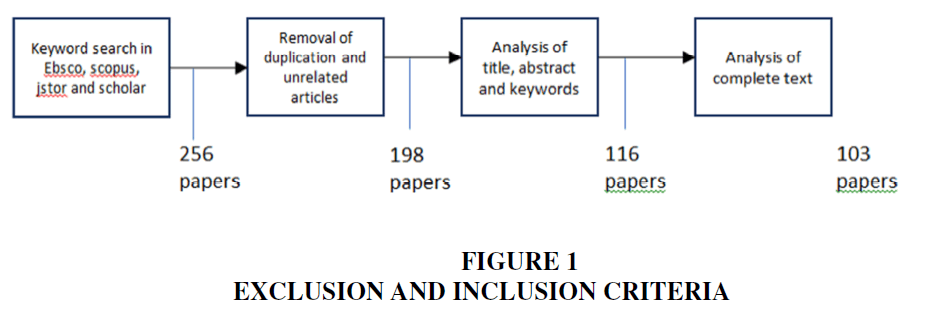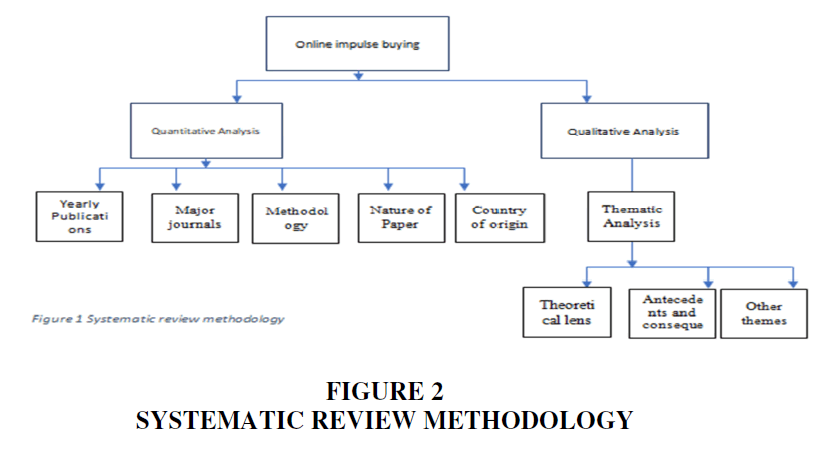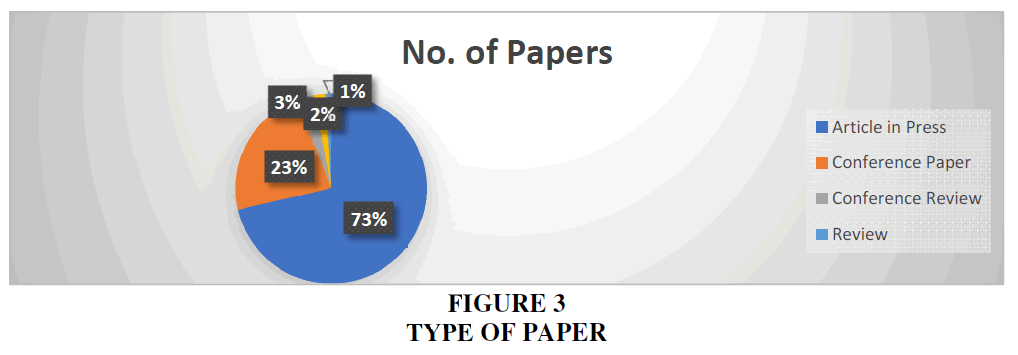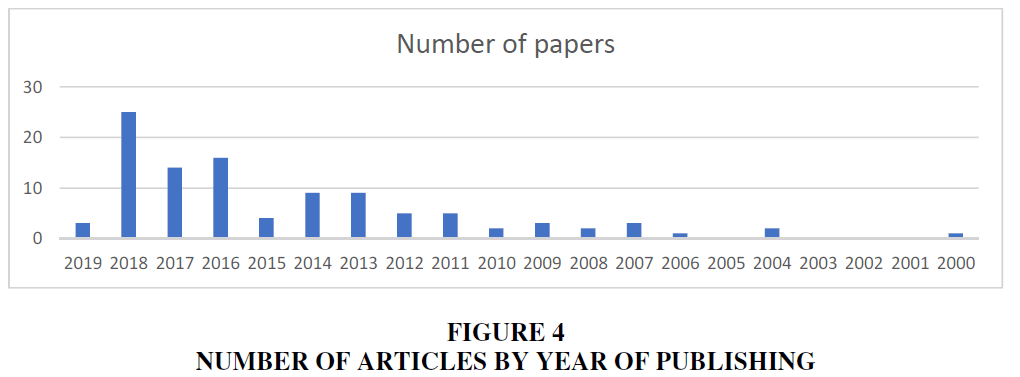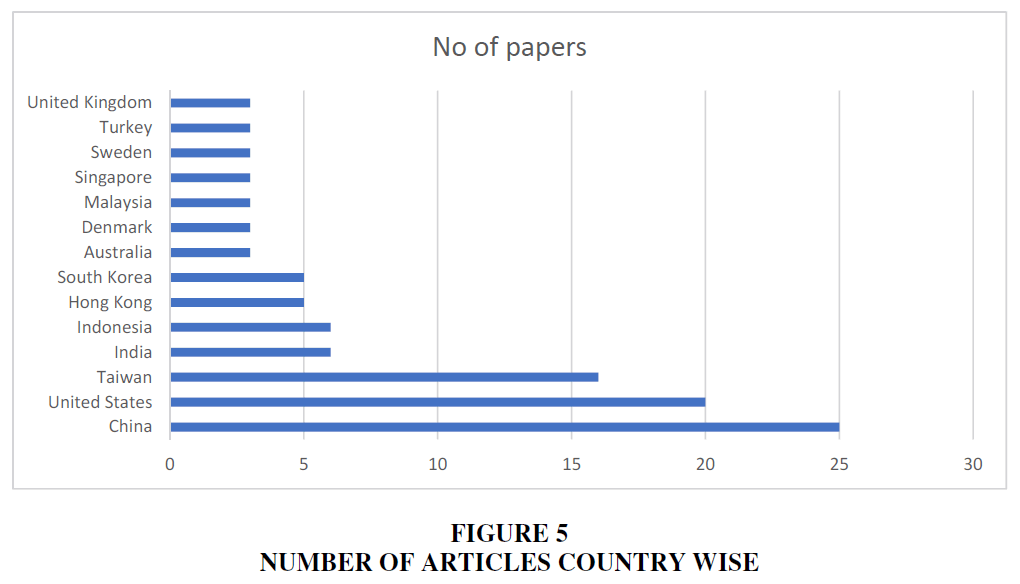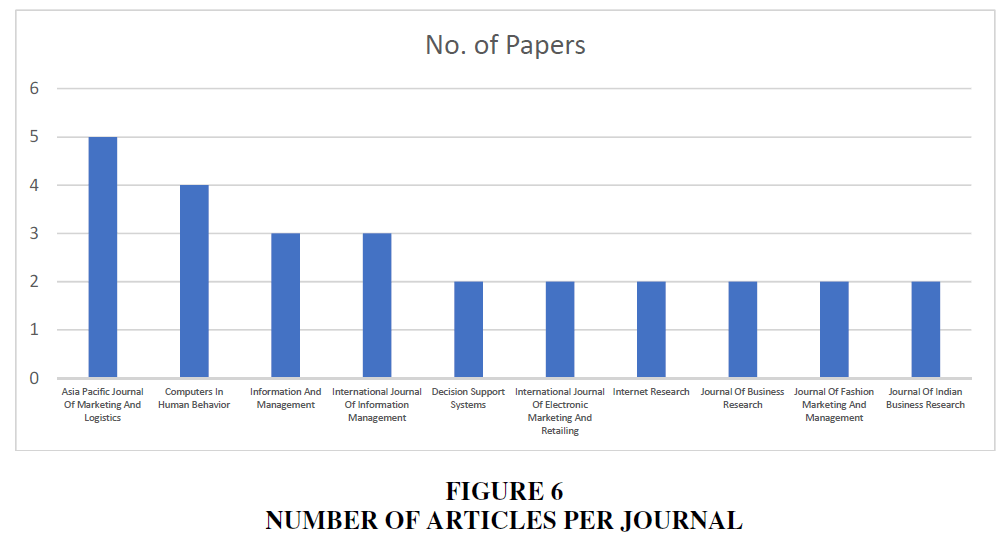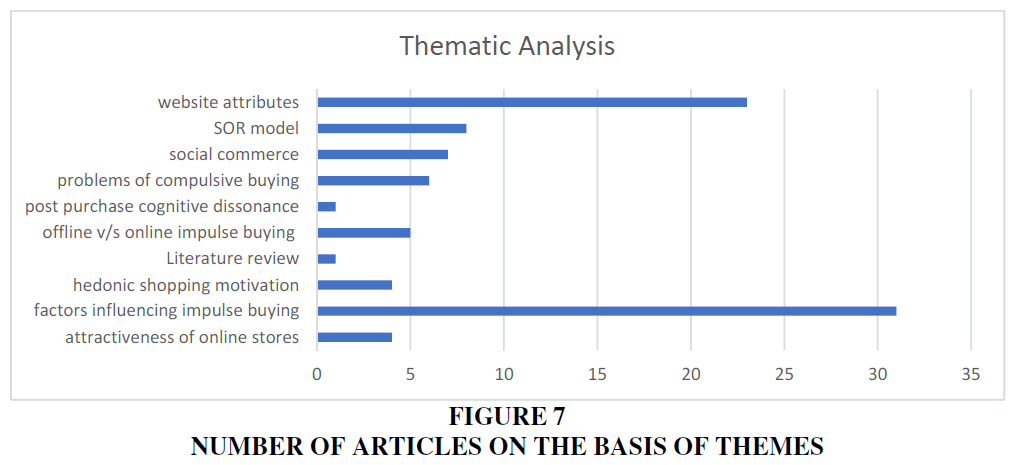Review Article: 2024 Vol: 28 Issue: 2
An Integrative Review on Online Impulse Buying: Antecedents and Consequences
Jyoti Tandon, Delhi Technological University, India
Vikas, GBSSS, Ashok Vihar, Delhi
Rajan Yadav, Delhi Technological University
Saurabh Agrawal, Delhi Technological University
Citation Information: Tandon, J., Vikas, Yadav, R., & Agrawal, S. (2024). An integrative review on online impulse buying: antecedents and consequences. Academy of Marketing Studies Journal, 28(2), 1-12.
Abstract
Purpose – With the spread of e-commerce, impulse purchase is rampant online, yet relatively limited research is existing on this phenomenon. This paper aims to synthesize the perspectives of online impulse buying behavior by linking the antecedents and consequences through the systematic literature review (SLR) of the relevant literature. Design/methodology- We present a literature review using the SLR methodology based on (Denyer & Tranfield, 2009a; Tranfield). Findings – The findings included antecedents, consequences and various theories strengthening impulse buying tendency. The SLR aimed at finding themes on which the included papers were based on. The themes included website attributes, attractiveness of online stores, factors influencing impulse buying, hedonic shopping motivation, offline v/s online impulse buying, post purchase cognitive dissonance, problems of compulsive buying, social commerce and SOR model. Practical implications –Given the importance of impulse purchases to the firm’s profit, the study provides valuable insights into impulse buying behavior in an online backdrop. Originality/value – To the best of the author’s knowledge, this is the first SLR of the emerging field of online impulse buying which focuses on the antecedents of the online buying process along with the potential consequences and emerging themes post year 2000.
Keywords
Online Impulse Buying, Consumer Behavior.
Introduction
With the rise of e-commerce, there is mounting sign that impulse purchase is occurring in the online context, yet relatively a smaller number of researchers have studied this phenomenon in the context of a variety of disciplines. One should understand e-impulse buying. Impulse buyers are not able to control their tendencies and behaviors from various stimuli. Online consumers are both the impulse shoppers as well as system users of websites in the purchase process. Impulse shoppers are impacted by individual traits whereas system users cover the attributes of online stores. There are two key drivers of online impulse buying behavior trust belief and technology use with the mediator of flow experience. Based on a systematic review of the literature published over the past 19 years, we synthesize various research perspectives into an integrative framework of online impulse buying by linking antecedents and consequences. The intention of this paper is to bring together all antecedents and consequences of online impulse buying behaviour by consolidating the extant research, establishing connections in disparate fields and identifying gaps between and within research streams.
The paper begins by presenting an overview of the methodology employed, followed by a review and classification of the results. The key findings of the review are then integrated into a framework of IB in online scenario including the antecedents and outcomes of buying.
Online Impulse Buying: Definition and Scope
Impulse buying is concerned with a situation when a consumer undergoes an unexpected, often influential and relentless urge to buy something instantaneously (Liu et al., 2013).
As described by Aruna and Santhi (2015), impulse buying behaviour is a novelty or escape purchase that disrupts the regular buying pattern. There are many studies which have emphasized the role of impulsiveness in online buying (Liu et al., 2013; Floh and Madlberger, 2013). Sultan (2002) scrutinized online impulsive purchasing behaviour. Luo (2005) in his study examined the impact of the presence of peers and family members on the urge to purchase online and found that the presence of peers has a positive effect on the call to buy online while the presence of family members has a negative effect on the same. There are four distinct types of impulse buying – Pure impulse buying, planned impulse buying, suggestive impulse buying, and reminder impulse buying. Pure impulse buying is a unique buying behaviour that halts a predictable purchase pattern. Reminder impulse buying is when a consumer gets introduced to the enriched information about the product, remembers an advertisement related to the product or after seeing the product when he consumer realizes the shortage of it at home. The third category is suggestive impulse buying which occurs when after seeing the product for the first time the customer develops a need to buy it. The fourth type of impulse buying is planned impulse buying which takes place when the decision to buy a product or service is driven by a discount in price (Madhavaram and Laverie, 2004). Existing literature on online impulse buying has largely focused on making an impulse sale (Chan et al., 2017). As much as 40% of all online consumer expenditure consists of online impulse buying (Liu et al., 2013). It is also established that the online shopping intensifies more impulse-buying behavior as compared to offline environment (Eroglu et al. 2001).
There are various reasons why people indulge in impulse buying. The most notable of them are: shopping environment, personal traits of the shopper, product itself and various socio-cultural and demographic aspects. Applebaum (1951) suggested how consumer's exposure to a stimulus in the store can lead to impulse buying. It has been established by that environment in the store impacts the emotional states of the customers, thus leading to impulse buying. Various visually appealing cues like promotional incentives stems impulse buying. (Dholakia, 2000). Consumers take impulsivity as a lifestyle trait and can link it to sensation seeking, materialism and indulging in shopping for recreational aspect of it (Rook, 1987). Hawkins et al. (2007) highlighted that differences and variety seeking behaviour triggers impulse buying. Functional benefits derived from a product can also trigger the impulse buying phenomenon (Schiffman et.al, 2010). The purchasers who do not decide the brand and features of the product before the actual purchase can be regarded impulse buyers (Goldsmith and Lofferty, 2002). It is possible for marketers to stimulate impulse buying (Barnes, 2003) the same can be done by considering time and location for text messages. It was recommended by the CEO of a German mobile marketing company that the ideal time to send a SMS to a customer should lie between 9:00 AM to 9:00 PM and that too only on weekends. Considering classes of students, they should be approached after noon (Schar et al., 2005). Besides time, the focus should also be shifted to frequency of the message and it should be limited to 2-4 messages per week (Bamba and Barnes, 2007). It is advisable for marketers to combine interactive responses with incentives and personalised message content to convert it into a successful impulse purchase (Yaniv, 2008).
Marketers can reach the target audience through online advertising, emails, texts and social media sites. To augment sales, the marketers must aim at minimizing time where a customer might reconsider a purchase and decide against it. “Impulse buying is defined as a powerful and spontaneous sudden urge to purchase a product straightaway” (Rook, 1987). Impulse buying takes place after an individual is exposed to a stimulus (Parboteeah, 2009). Piron (1991) focused on how individuals process the stimuli psychologically using cognitive (rational) and affective (emotional) aspects. However, it has been well established by Coley and Burgess (2003) that affective and cognitive aspects are interconnected in prompting impulse buying behaviour. Hedonic reasons like entertainment leads to greater propensity towards impulse purchase (Beatty and Ferrell, 1998). The smartphone users are intimidated by features like ease and immediacy to buy product and services, thus leading to increased impulse buying. Impulse buyers spare less time to the buying decision-making process.
Previous literature have seen the impact of impulsiveness in online shopping. However, the outcome of impulsiveness in m-commerce (email, SMS) remains unmapped. (Wilska, 2003). It is pre-established that mobile advertising would be more effective for products that are frequently bought and are low-priced as compared to expensive products (Barwise and Strong 2002). Huang and Hsieh (2011) show that the positive feeling experienced by consumers increases impulse buying.
Most shoppers occasionally engage in impulse buying (Welles, 1986). The internet gives air to impulse buying because of advantages like shopping at leisure, 24*7 shopping benefits and convenience of shopping at home (Phau and Lo, 2004). Internet Retailer (2002) established that as much as over 75% of online retailers use up-selling and cross-selling strategy to increase the order size. Various strategies by online marketers like up-selling and cross-selling through sale items, discounted items, featured articles, product recommendations, and suggested items further promote impulse buying. Impulse buyers are less concerned about the costs of purchasing on impulse (Rook, 1987) also the probability of them evaluating their purchase decisions as compared to an informed shopper is less (Jones et al., 2003).
As per Mburu, 2010 women enjoy shopping more than men, and that's how there is a decreased chance of men being engaged in an impulsive buying decision. According to psychology literature, a person in a good mood is experiencing positive affect, and so he will prefer approaching behavior more than avoidance behavior (Beatty & Ferrell, 1998). Now, to maintain a positive mood state, they should reward themselves (Isen, 2001). Some shoppers feel stress and sadness which conceptualize negative affect (Beatty & Ferrell, 1998).
Huang and Kuo (2012) probed the relation between customers’ mood and impulsivity in online shopping decisions and also how it can be regulated by participation. Liu et al. (2013) attempted to examine the impact of website cues on personality traits to urge online impulse purchase. Unplanned buying behaviour commonly refers to the number of articles put in the basket in comparison to the shopping list (Bell; Corsten and Knox 2011; Hui et al., 2013). Aruna and Santhi (2015) examined the impact of the age factor on impulse buying and concluded that Generation Y is more inclined to “impulse buying” as compared to other people. There has been a substantial increase in the number of online stores visited by consumers and time spent in such online stores because of the persistent growth of e-commerce and immense internet penetration in society due to smartphones (Melis et al., 2015).
Review Approach
To conduct a systematic review of the extant literature base, a systematic review methodology was followed in order to confirm an unbiased and valid assessment; (Tranfield et al., 2003). Systematic reviews deploy a series of steps to minimize the bias and keep the review free of error through exhaustive literature searches of the extant research in the field. The five steps of a SLR are:
(1) “Problem formulation”;
(2) “Literature search”;
(3) “Evaluation of research”;
(4) “Research analysis and interpretation”; and
(5) “Presentation of results”
A comprehensive review of the existing bodies of literature on online purchase behavior, impulse buying, compulsive buying and e-commerce were conducted beginning with a search on two widely searched databases i.e. Scopus, Jstor and Ebsco along with google scholar.
We considered articles with management and technology focus only. In the initial step, we were able to generate a total of 256 papers. After removing duplication in outcomes, the total number of articles were slashed down to 198.After that the papers that don’t meet our inclusion criteria were removed. The exclusion and inclusion criteria are discussed in Table 1.After this stage we were left with 116 papers. Lastly, each article was read carefully to answer questions like whatis the status of extant literature on online impulse buying? What are the key emerging themes? After the screening, only 103 papers remained. Figure 1 gives the overview if the systematic review process. In the succeeding sections we analyze these papers in detail.
Thereafter frequency analysis was carried out to understand the distribution of papers across journals and conferences, publication year and the research methods used. The qualitative analysis of the studies was carried out while keeping a focus on the following premises: theoretical lens; Antecedents and consequences and other emerging themes Figures 2-7.
General Characteristics of Included Studies
First, a descriptive summary of the distinct features of the included studies is presented, including types of paper, publication of articles by year, journals and origin of country. Fig. 3 represents the dissemination by type of papers. Out of the total, as many as 73% are the articles in press followed by 23% being paper from conference proceedings, 3% from conference review and remaining 1% are review papers. The first publication taken in consideration was in the year 2000. Until 2006, only four papers on online impulse buying was included in studies with no publications in 2001, 2002 and 2003. Since 2015, the number of publications has amplified steadily, with highest being in the year 2018.
Descriptive Analysis
The interest in online impulse buying has gained a popularity since 2004. The present research includes empirical papers constituting the largest share (53%), theoretical papers (34%), mathematical modelling (2%), literature reviews signify the smallest share (1%), there were no
meta-analyses found. 10% of the papers did not fit the set categorization at all.
Type of Paper
Number of Articles by Year
Number of Articles by Country
Qualitative Analysis
Antecedents and Consequences
Dewi et al. (2017) conducted a research on 124 respondents and concluded that multiple individual factors such as materialism, personality traits, culture and shopping enjoyment tendency are responsible for online impulse buying. They used big five personality traits to explain various dimensions like extraversion and openness to experiences signifying positive effect on impulse buying and agreeableness, conscientiousness and emotional stability depicting negative effect.
Other studies also pointed the importance of discount, hedonic consumption, positive emotion, and visual merchandising in impacting impulse buying in online scenario. For example, visual merchandising and discount lead to online impulse buying whereas hedonic consumption and positive emotion were considered as process (Suhud & Herstanti, 2017). In the literature, impulse buying has been associated with browsing emotionally and hedonically. Hedonic consumption has been studied with the focus on lifestyle, experience, routine, prestige, and enjoyable dimensions. Therefore, it can be understood from the analysis of literature that studies on hedonic consumption focus primarily upon the enjoyable aspects of shopping. These aspects are fun and entertainment and they are present whether or not purchase takes place. (Park et. al., 2012) through the research concluded that in the context of online community content providers give more weightage to atmosphere factors in the virtual community but in addition to website quality, individual traits such as a tendency to impulsiveness be considered in this context promulgated that flow experience and perceived transaction value have positive impact on impulse buying behavior. It was also established that positive relationship between positive affect and impulse buying behavior was moderated by hedonic shopping motivation.
As per the result obtained in their study, the key factors influencing consumers’ online impulsive buying behavior are mainly intrinsic factors including impulsive buying tendency, shopping enjoyment tendency and personality. Consumers high on personality dimensions of extraversion and low on dimension of conscientiousness trait are affected by online impulse buying.It is established that the product attributes did not have any significant effect on impulse buying behavior. In the context of web browsing activities, hedonic web browsing has higher probability to be able to make a real purchase, thus leading to impulse buying identified promotions and ideas to be two main categories to indicate the possibility of online impulse buying. According to online buyers, promotions and purchase ideas are the two categories of external cues available on apparel websites that induce people to buy impulsively. Promotional cues include a free gift with purchase, sales promotions, contests or sweepstakes, free shipping as well as lenient return policies. The idea cues include featured items, new styles, top picks and gift ideas. The findings of the research established that there is a tendency in online shoppers to value all external cues on a website differently. The most desired cues were promotional offers and purchase ideas. Wei, Ma, & Chen (2017) discovered three major findings: The quality of the website has a positive relation with e-impulse buying behavior, secondly sales promotion significantly effects online impulse buying and acts as a strong moderator in the association between website quality and e-impulse buying. Thirdly, e-impulse buying is positively influenced by use of credit card and its usage further strengthens the relationship between website quality and e-impulse buying.
Buying impulsiveness is a surface trait which has a positive relationship with internet addiction; a situational trait, need for arousal and need for material resources both being elemental traits. It has a negative correlation with task orientation which is a compound trait. Emotional instability has a positive effect on Internet addiction. Conscientiousness is positively related to task orientation.
Theoretical Perspective
Regulatory focus theory and found two factors which impact consumer’s impulse buying, cognitive dissonance and satisfaction. It is believed that these two factors lead to consumer loyalty, both behavioural and attitudinal loyalty. These two factors are personality characteristics which are promotion and prevention focus. Regulatory theory is a psychological theory used in the understanding of various psychological constructs like persuasions and motivations. As per theory of reasoned action developed by Fishbein and Ajzenthe consumer behavior can be anticipated from its corresponding intentions (Thamizhvanan & Xavier, 2012) and it is further used by Jih et al., (2008) to examine consumer behavior regarding mobile advertising, thus leading to online impulse buying. Browsing on the web is a prominent factor affecting online impulse buying for purchasing apparels in both hedonic and utilitarian viewpoints (Rezaei et al. 2015). It actually led to broadening of the scope of impulse buying behaviour theory (Baumeister, 2002) conducted a field experiment online and empirically investigated the effects quality of message of the advertisement, number of “likes” received by advertisement and the trait of the impulsiveness to shop impulsively. The findings of the study were consistent with latent state–trait theory, observational learning and heuristic information processing.
The mood relevant cues instead of task relevant cues can enhance impulse purchase intention through ease of use perceived by consumers, usefulness and playfulness. The structural equation modeling was used in the methodology to depict the same. (Chen, et al. 2017).
Herzberg’s two-factor theory focuses on identifying the hygiene and motivation factors that trigger online impulse buying. However, the findings of Lo, Lin and Hsu (2016) stated that what we call triggers of online buying behavior are not same as triggers of online impulse buying. It established that implications for impulse buying research and practice are different and yet novel. Human behavior can be predicted from characteristics of the environment, individual traits possessed by consumers and the interaction of these two features (Steyer et al., 1999). It is established in the theory that individuals who engage in impulse purchases are more likely to share common personality traits and characteristics (Youn and Faber, 2000). Kaisheng (2010) in his paper investigated the features of online Word-of-Mouth and proposes a hypothetical model portraying the relationships between e-impulse buying and online word-of-mouth through time spent on online browsing. Wu et al., (2016) approached a study in an integrated manner and dealt with three vital issues namely website use, flow experience and trust belief. These issues had an important effect on e-impulse purchase. The effect could be seen either in individual form or in a consolidated form. In the subsequent studies, the importance of trust was highlighted such that it influences online impulse buying.
Thematic Analysis
Widely discussed topics in the extant literature are surveyed and assessed in this section. The various themes on which the 91 papers in consideration are based on includes website attributes, attractiveness of online stores, factors influencing impulse buying, hedonic shopping motivation, offline v/s online impulse buying , post purchase cognitive dissonance, problems of compulsive buying, social commerce and SOR model.
Website Attributes
It has been well established in the literature that website cues including products availability, visual appeal and website ease of use have an impact on personality traits and leads to online impulse buying (Liu, et al. 2013). There are two types of web browsing utilitarian browsing and hedonic browsing. If there are several options to choose from this phenomenon has a positive outcome on utilitarian web browsing, however if there is some benefits from price aspect, this leads to a positive effect on hedonic web browsing. For apparels on online shopping websites, utilitarian web browsing has a negative relationship with impulse buying and hedonic web browsing has a positive effect on impulse buying behavior stated that website quality is that environmental cue which affects consumers’ willingness to buy impulsively. In addition to this, with varying degrees of website quality, there can be both a positive and a negative impact on highly impulsive consumers focused on interactive features of ecommerce sites like "clickable" product arrays and email alerts of special offers and proved its presence in unregulated buying activity. Akram et al., (2018) further strengthens the relationship of website quality and online impulse buying with an added dimension of use of credit cards. It was established that e-impulse purchases are positively influenced by use of credit card, and use of credit card strengthens the association between website quality and online impulse buying.
Attractiveness of Online Stores
Verhagen & Dolen (2012) established that enjoyment, merchandise attractiveness and online store communication style after being mediated by consumers' emotions leads to online impulse buying. Due to the presence of online product presentations, the perceptions of participants’ gets increased about the product and the participant takes it equivalent to product being present with him in his or her local environment (Vonkeman, et al. 2017). Further in congruence with the two-factor theory by Herzberg the hygiene factors in the form of design of online stores and motivation factors using sales promotion stimuli as triggers to online impulse buying (Lo et al. 2016). The online store belief influences consumer online impulse purchase for both hedonic and utilitarian (Zhou, et al. 2014).
Factors Influencing Impulse Buying
The propogation existence of a positive relationship between affective state and e-impulse-buying behavior and a negative association between a person's cognitive state and online impulse-buying behavior. In accordance with the concept of mental accounting, if the total amount spent on other items increases there is a high tendency that purchases of impulse products increases. The price discounts led to higher impulse buying intention than as compared to bonus packs in hedonic products whereas bonus packs acted as a better sales promotion plan than discounts in price in case merchandise was a utilitarian one. Akram et al., (2017) demonstrated that both motivational and emotional factors have a positive influence online impulse buying. Out of several other variables considered, perceived ease of use has less influence on online impulse buying. Impulsive purchase behavior can be affected by information quality of the website and customer's usage of interactive features (Lin & Chuan, 2013). Kaisheng (2010) scrutinized and established a relationship between impulse buying behavior in online context and online Word-of-Mouth. The study conducted by the two hypotheses H1 and H2 revealed that when cost precedes benefits, in an online impulse buying scenario, with time, the dissonance keeps on decreasing, whereas "buy now, pay later" established the increase in dissonance with time in the same situation.
Hedonic Shopping Motivation
Online shopping behaviors are affected by hedonic shopping motivation the pre-purchase browsing time gets impacted. It was also propounded that pre-purchase browsing period has a direct association with frequency of online purchase. The magnitudes of hedonic shopping like relaxation, value and adventure positively impact e-impulse purchase. However, social shopping negatively impacts online impulse buying behavior (Ozen & Engizek, 2014).
Post Purchase Cognitive Dissonance
If the purchase arguments are strong and in bulk quantity, there is a significant positive effect on online satisfaction. The impact will be more for consumers with high tendency to regret as compared to low tendency-to-regret consumers (Chang & Tseng, 2014).
Problems of Compulsive Buying
College students who had traits of compulsive buying displayed significantly greater psychiatric comorbidity, increased stress, lower grade point averages and poorer physical health as compared to the ones not having traits of compulsive buying further emphasized that impulse purchases can lead to an increase in product returns and can augment the feelings of buyers' remorse. The findings of is a consequence of the fact that online impulse buying could harm someone psychologically and financially.
Social Commerce
E-commerce has a new branch, known as social commerce which is aimed at making the experience of consumers on social commerce platform (SCP) distinct from other contexts because the consumers are a social animal and they interact amongst each other. Consumer’s perceived enjoyment and impulse buying tendencies influence the urge of consumers to buy impulsively (Xiang, et al. 2016). It is established by that while the consumers browse online group shopping websites; these online social interactions may affect the consumer’s willingness to buy impulsively. Call to action buttons introduced by Instagram has positive correlation with consumers' impulsive purchase, but it is less effective in improving consumers' perceived enjoyment. E-commerce has a new branch, known as social commerce which is aimed at making the experience of consumers on social commerce platform (SCP) distinct from other contexts because the consumers are a social animal and they interact amongst each other. Consumer’s perceived enjoyment and impulse buying tendencies influence the urge of consumers to buy impulsively (Xiang, et al. 2016). It is established by that while the consumers browse online group shopping websites; these online social interactions may affect the consumer’s willingness to buy impulsively. Call to action buttons introduced by Instagram has positive correlation with consumers' impulsive purchase, but it is less effective in improving consumers' perceived enjoyment.
Conclusion
We make a contribution to the literature by gathering arguments in relation to the antecedents and consequences of online impulse buying. Most importantly we identified antecedents and consequences as follows. Antecedents: individual factors like materialism, personality traits, culture and shopping enjoyment tendency, discount, hedonic consumption, positive emotion, visual merchandising, atmosphere factors like website quality, flow experience and perceived transaction value, intrinsic factors like impulsive buying tendency, shopping enjoyment tendency, promotions and purchase ideas. Various themes related to online impulse buying were discovered like website attributes, attractiveness of online stores, factors influencing impulse buying, hedonic shopping motivation, offline v/s online impulse buying, post purchase cognitive dissonance, problems of compulsive buying, social commerce and SOR model. We contributed to the online impulse buying research by providing a comprehensive understanding of the topic. Also, identified the constructs that have been used and utilized in the online impulse buying empirical literature. We have tried to uncover the complex relationships between different antecedents and consequences to the online impulse buying. Our SLR is multi-disciplinary in nature and this shows the importance of analyzing and understanding the existing literature on online impulse buying. Addressing the antecedents and consequences of online impulse buying would help the practitioners and managers to understand how it can be improved. Financial perspective and the economic outcomes captured in some of the papers reviewed in this study, would help to quantify the business performance. This study, like any other study, is not free from limitations. The discussion on inter-relationship between antecedents of online impulse buying and impulse buying as well as consequences of online impulse buying and impulse buying requires further exploration. Also, the future studies can look at the stakeholder perspective as we have only taken into consideration the customer perspective.
References
Akram, U., Hui, P., Kaleem Khan, M., Tanveer, Y., Mehmood, K., & Ahmad, W. (2018). How website quality affects online impulse buying: Moderating effects of sales promotion and credit card use. Asia Pacific Journal of Marketing and Logistics, 30(1), 235-256.
Indexed at, Google Scholar, Cross Ref
Chen, T. Y., Yeh, T. L., & Lo, W. C. (2017). Impacts on online impulse purchase through perceived cognition. Journal of International Consumer Marketing, 29(5), 319-330.
Indexed at, Google Scholar, Cross Ref
Denyer, D., & Tranfield, D. (2009a). Producing a systematic review.
Kaisheng, Z. (2010). Online buying impulsiveness and word-of-mouth online in the e-marketing age: A theoretical model approach. In 2010 International conference on management of e-Commerce and e-Government (pp. 133-136). IEEE.
Lin, J., & Chuan, C. H. (2013). A study on youth online impulsive purchase: The relationship between individual difference, shopping environment, emotion response and purchase. Journal of Creative Communications, 8(2-3), 209-229.
Indexed at, Google Scholar, Cross Ref
Liu, Y., Li, H., & Hu, F. (2013). Website attributes in urging online impulse purchase : An empirical investigation on consumer perceptions. Decision Support Systems, 55(3), 829–837.
Indexed at, Google Scholar, Cross Ref
Lo, L. Y. S., Lin, S. W., & Hsu, L. Y. (2016). Motivation for online impulse buying: A two-factor theory perspective. International Journal of Information Management.
Indexed at, Google Scholar, Cross Ref
Tranfield, D., Denyer, D., & Smart, P. (2003). Towards a methodology for developing evidence‐informed management knowledge by means of systematic review. British journal of management, 14(3), 207-222.
Verhagen, T., & van Dolen, W. (2011). The influence of online store beliefs on consumer online impulse buying: A model and empirical application. Information & Management, 48(8), 320-327.
Indexed at, Google Scholar, Cross Ref
Vonkeman, C., Verhagen, T., & Van Dolen, W. (2017). Role of local presence in online impulse buying. Information & management, 54(8), 1038-1048.
Indexed at, Google Scholar, Cross Ref
Wei, W. J., Ma, Z. J., & Chen, Y. W. (2017). Empirical Study of the Relationship Between Flow Experience, Perceived Transaction Value and Impulse Buying Behavior, 2246–2250.
Wu, I. L., Chen, K. W., & Chiu, M. L. (2016). Defining key drivers of online impulse purchasing: A perspective of both impulse shoppers and system users. International Journal of Information Management, 36(3), 284-296.
Indexed at, Google Scholar, Cross Ref
Xiang, L., Zheng, X., Lee, M. K., & Zhao, D. (2016). Exploring consumers’ impulse buying behavior on social commerce platform: The role of parasocial interaction. International journal of information management, 36(3), 333-347.
Indexed at, Google Scholar, Cross Ref
Zhou, Q., Chen, X., & Chen, Y. W. (2014). Influence of online store belief and product category on impulse buying: An empirical investigation on consumer perceptions. In 2014 IEEE International Conference on Industrial Engineering and Engineering Management (pp. 1453-1456). IEEE.
Indexed at, Google Scholar, Cross Ref
Received: 01-Aug-2023, Manuscript No. AMSJ-23-13844; Editor assigned: 02-Aug-2023, PreQC No. AMSJ-23-13844(PQ); Reviewed: 29- Sep-2023, QC No. AMSJ-23-13844; Revised: 20-Oct-2023, Manuscript No. AMSJ-23-13844(R); Published: 01-Jan-2024
